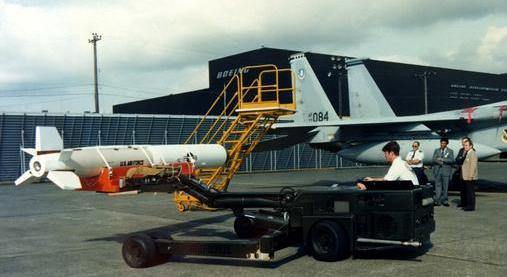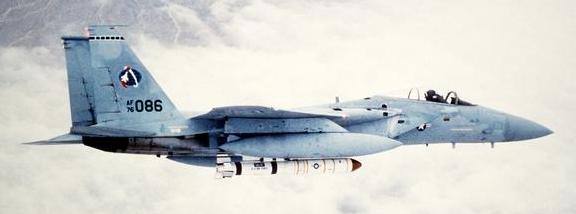Vought ASM-135 ASAT
After that Soviet Union had developed a "killer satellite" to disable other satellites in the 1970s, the U.S. Air Force decided to develop an anti-satellite weapon system. The ASAT (Anti-Satellite Missile) program began around 1977, and in 1979 Vought was awarded a contract to develop an air-launched missile for use agianst low-earth orbit satellites. The ASAT missile, also known as ALMV (Air-Launched Miniature Vehicle), was designed as a multi-stage rocket, which was to be launched by an F-15 Eagle interceptor in a zoom-climb. Captive flight tests with ASAT vehicles on a modified F-15A began in 1982, and the first launch aimed at a predefined point in space occurred in early 1984.
 |
| Photo: USAF |
| ASM-135A |
The ASAT missile used the SR75-LP-1 solid-propellant rocket of the AGM-69 SRAM as the first stage and a Vought Altair III (the 4th stage of Vought's Scout B) with a Thiokol FW-4S motor as second stage. It was launched by an F-15 in a high-altitude supersonic climb. The F-15's computer was updated with special guidance algorithms, and the head-up display was also modified to provide additional steering cues to the pilot. This was necessary, because the zoom-climb and missile release had to be flown exactly as calculated to get the missile near the target satellite. The second stage of the ASAT pointed the MHV (Miniature Homing Vehicle) "warhead" in the target's direction, so that the latter's infrared image could be detected by the MHV's telescopic seeker. The MHV was spin-stabilized, used 63 small short-pulse rocket motors for manoeuvering, and destroyed the target by a direct hit at a speed of at least 24000 km/h (15000 mph). The maximum intercept altitude for the ASAT missile was at least 560 km (350 miles), and possibly as high as 1000 km (620 miles).
On 13 September 1985, the first and only destruction of a satellite by an American air-launched missile occurred, when an F-15A launched an ASAT against the solar observatory satellite "P78-1" in a 600 km (375 mile) orbit. Although the satellite was beyond its design life-time, it was still working, and its destruction led to some protests by scientists. This was the only full-scale live test of the Vought ASAT missile, and shortly after that, the missile was officially designated ASM-135A. Although "ASM" could be conveniently read as "Anti-Satellite Missile", the designation was non-standard because intercept missiles are normally designated "AIM". Inert test missiles for captive flights were designated CASM-135A.
 |
| Photo: USAF |
| ASM-135A |
The USAF planned to procure up to 112 ASM-135A missiles for use by twenty modified F-15A interceptors. However, the program was terminated in 1988, partly for political reasons because the ASAT might violate treaties about the military use of space.
Specifications
Note: Data given by several sources show slight variations. Figures given below may therefore be inaccurate!
Data for ASM-135A:
| Length | 5.42 m (17 ft 9.5 in) |
| Diameter | 51 cm (20 in) |
| Weight | 1180 kg (2600 lb) |
| Speed | > 24000 km/h (15000 mph) |
| Ceiling | > 560 km (350 miles) |
| Propulsion | First stage: Lockheed Propulsion Co. SR75-LP-1 solid-fueled rocket Second stage: Vought Altair III solid-fueled rocket; 27.4 kN (6160 lb) for 27 s |
| Warhead | Vought MHV "hit-to-kill" vehicle |
Main Sources
[1] Christopher Chant: "World Encyclopaedia of Modern Air Weapons", Patrick Stephens Ltd., 1988
[2] Bernard Blake (ed.): "Jane's Weapon Systems 1987-88", Jane's, 1988
[3] Dr. Raymond L. Puffer: "Death of a Satellite" (originally at http://www.edwards.af.mil/moments/docs_html/85-09-13.html,
now dead link)
[4] John Pike: GlobalSecurity.org Website
Back to Current Designations Of U.S. Unmanned Military Aerospace Vehicles
Back to
Directory of U.S. Military Rockets and Missiles
Last Updated: 29 December 2004